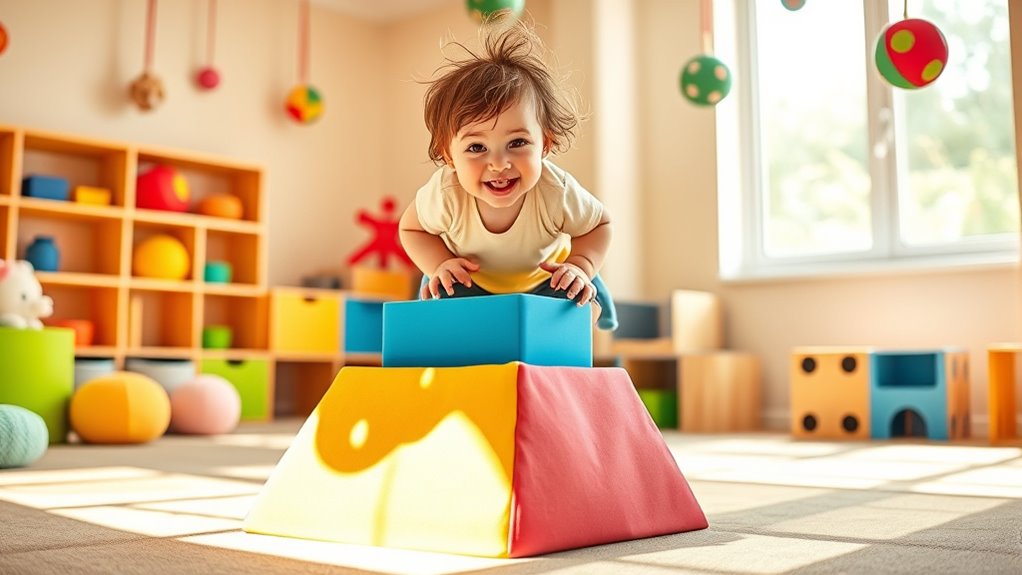Your toddler loves to climb because it’s a natural way for them to explore, develop motor skills, and build confidence. While climbing is exciting, it also comes with safety risks, so you need to supervise closely and baby-proof your home. Secure furniture, use safe climbing structures, and keep an eye on your child at all times. Stay tuned to learn effective ways to make climbing both fun and safe for your little adventurer.
Key Takeaways
- Toddlers climb driven by curiosity, helping develop motor skills, confidence, and exploration instincts.
- Supervise closely and secure furniture and windows to prevent falls and injuries during climbing.
- Use safe, age-appropriate climbing structures and soft mats to minimize risks.
- Teach safe climbing techniques, like descending carefully, and set clear boundaries for safe areas.
- Keep the environment safe by removing hazards, covering outlets, and maintaining constant supervision.

Climbing is a natural curiosity for toddlers, but it can also pose serious safety risks if not properly supervised. As a parent, you want to encourage their exploration while keeping them safe. That’s where baby proofing tips come into play. Start by evaluating your home environment and identifying potential hazards. Secure furniture that could tip over, lock cabinets containing sharp or dangerous objects, and install safety gates at the top and bottom of stairs. These simple steps help minimize accidents and give your child the freedom to explore within safe boundaries.
Supervise your toddler’s climbing, secure furniture, and install safety gates to create a safer exploration environment.
When it comes to climbing gear, it’s important to choose age-appropriate equipment. For indoor play, consider soft climbing blocks, foam mats, or low, sturdy steps designed specifically for toddlers. These provide a safe surface for your child to practice climbing without the risk of serious injury. If your little one loves outdoor adventures, invest in toddler-friendly climbing structures that are made with durable, non-slip materials and have rounded edges. Always supervise closely when they’re using these structures, and verify they’re securely anchored to prevent tipping.
Baby proofing tips also include managing the height and accessibility of items your child might try to climb on. Keep furniture away from windows and remove any objects that could serve as a stepping stool to reach higher places. Cover electrical outlets and secure cords out of reach to prevent tripping or pulling hazards. Remember, even the most cautious toddlers can be unpredictable, so constant supervision is vital whenever they’re climbing.
In addition to physical safety measures, fostering a sense of safe climbing habits is important. Teach your toddler to climb down carefully instead of jumping or climbing headfirst. Show them how to use their hands and feet properly on climbing gear and encourage them to take their time. Setting clear boundaries and explaining that climbing should be done in safe areas helps develop responsible behaviors early on.
Furthermore, understanding the importance of trust-building activities in nurturing your child’s confidence can help them feel more secure during their explorations. Finally, always stay vigilant. Children can be quick and curious, so it’s best to stay within arm’s reach when they’re exploring new climbing spots. Combining thoughtful baby proofing tips with suitable climbing gear creates a safer environment where your toddler can satisfy their natural urge to climb while minimizing the risk of injuries. Your attentive supervision and careful planning will let your child enjoy their adventures and grow confident in their abilities, all while staying safe.
Frequently Asked Questions
At What Age Should I Start Introducing Climbing Activities?
You can start introducing simple climbing activities around 12 to 18 months, as your toddler begins to develop climbing milestones and improve their coordination. At this stage, they’re eager to explore, and safe, supervised climbing helps build strength and confidence. Make certain the climbing equipment is age-appropriate and always watch your child closely. As they grow, you can gradually introduce more challenging climbs to support their development.
How Can I Encourage Safe Climbing Without Restricting My Child’s Exploration?
Imagine guiding your child’s adventurous spirit as a gentle river flowing through a safe valley. To encourage safe climbing, you can teach them risk assessment, helping them recognize boundaries. Choose safe material selection for climbing structures, ensuring sturdy, non-toxic, and smooth surfaces. By blending encouragement with safety measures, you let their curiosity soar while keeping potential falls or injuries at bay, nurturing independence without unnecessary restrictions.
Are There Specific Climbing Toys or Furniture Recommended for Toddlers?
You should consider investing in indoor climbing toys or toddler gyms designed specifically for young children. These products are made with safety and durability in mind, providing a secure space for your kid to explore. Look for options with soft mats and sturdy structures, ensuring your toddler can climb confidently while minimizing risks. These toys promote safe indoor climbing, helping your child build strength and confidence in a controlled environment.
What Are Signs of Overexertion or Fatigue During Climbing?
Oh, the thrill of watching your tiny acrobat conquer the world! But beware, signs of overexertion aren’t subtle—muscle exhaustion shows in drooping limbs, heavy breathing, or fussiness. Behavioral cues like whining or refusal to continue signal fatigue. Keep a close eye, offer breaks, and guarantee they rest before turning into a toddler version of a marathon runner collapsing at the finish line. Safety first, even in the wild jungle gym!
How Do I Balance Supervision and Independence During Climbing Play?
When balancing supervision and independence during climbing play, you should use parentechniques to guide your child’s exploration while encouraging confidence. Conduct riskassessment to identify safe climbing spots and set clear boundaries. Stay close enough to intervene if needed, but allow your toddler to take manageable risks. This approach fosters independence and builds trust, helping your child develop skills while keeping safety a priority.
Conclusion
Remember, while it’s natural for your toddler to love climbing, safety always comes first. Keep a watchful eye and create a secure environment so they can explore freely without falling into trouble. With proper supervision and safety measures, you can let them reach for the stars while keeping their feet firmly on the ground. After all, it’s better to be safe than sorry—sometimes, a little caution can save the day and keep your little explorer happy and healthy.










